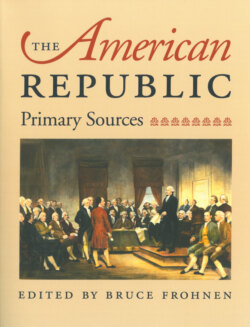Читать книгу The American Republic - Группа авторов - Страница 6
На сайте Литреса книга снята с продажи.
ОглавлениеContents
Alphabetical Table of Contents
Alphabetical List of Authors
Introduction
Note on the Texts
I Colonial Settlements and Societies
Virginia Articles, Laws, and Orders, 1610–11
The Mayflower Compact, 1620
Fundamental Orders of Connecticut, 1639
The Massachusetts Body of Liberties, 1641
Charter of Liberties and Frame of Government of the Province of Pennsylvania in America, 1682
Dorchester Agreement, 1633
Maryland Act for Swearing Allegiance, 1638; Plymouth Oath of Allegiance and Fidelity, 1625
“Little Speech on Liberty,” JOHN WINTHROP, 1645
“Copy of a Letter from Mr. Cotton to Lord Say and Seal,” JOHN COTTON, 1636
2 Religious Society and Religious Liberty in Early America
“The Bloody Tenent, of Persecution, for Cause of Conscience,” ROGER WILLIAMS, 1644
“A Platform of Church Discipline,” JOHN COTTON, RICHARD MATHER, and RALPH PARTRIDGE, 1649
Providence Agreement, 1637; Maryland Act for Church Liberties, 1638; Pennsylvania Act for Freedom of Conscience, 1682
Worcestriensis, 1776
“Thanksgiving Proclamation” and Letters to Religious Associations, GEORGE WASHINGTON; 1789, 1790
“Farewell Address,” GEORGE WASHINGTON, 1796
“The Rights of Conscience Inalienable,” JOHN LELAND, 1791
“Letter to the Danbury Baptist Association,” THOMAS JEFFERSON, 1802
3 Defending the Charters
Magna Charta, 1215
Petition of Right, 1628
“An Account of the Late Revolution in New England” and “Boston Declaration of Grievances,” NATHANAEL BYFIELD, 1689
The English Bill of Rights, 1689
The Stamp Act, 1765
“Braintree Instructions,” JOHN ADAMS, 1765
Resolutions of the Virginia House of Burgesses, 1765; Declarations of the Stamp Act Congress, 1765
“The Rights of the British Colonies Asserted and Proved,” JAMES OTIS, 1763
The Act Repealing the Stamp Act, 1766; The Declaratory Act, 1766
4 The War for Independence
“A Discourse at the Dedication of the Tree of Liberty,” “A SON OF LIBERTY” [silas downer], 1768
“Letters from a Farmer in Pennsylvania,” Letters V and IX, JOHN DICKINSON, 1767–68
Declaration and Resolves of the First Continental Congress, 1774 154
Virginia Bill of Rights, 1776
“On Civil Liberty, Passive Obedience, and Non-resistance,” JONATHAN BOUCHER, 1775
Common Sense, THOMAS PAINE, 1776
The Declaration of Independence, 1776
5 A New Constitution
“Thoughts on Government,” JOHN ADAMS, 1776
Articles of Confederation, 1778
The Essex Result, 1778
Northwest Ordinance, 1787
Albany Plan of Union, 1754
Virginia and New Jersey Plans, 1787
The Constitution of the United States of America, 1787
The Federalist, Papers 1, 9, 10, 39, 47–51, 78; ALEXANDER HAMILTON, JAMES MADISON, and JOHN JAY; 1787
“Address of the Minority of the Pennsylvania Convention,” 1787
“An Examination of the Leading Principles of the Federal Constitution,” NOAH WEBSTER, 1787
6 The Bill of Rights
The Federalist, Papers 84 and 85; ALEXANDER HAMILTON, JAMES MADISON, and JOHN JAY; 1787
“Letter I,” “CENTINEL,” 1787
“Essay I,” “BRUTUS,” 1787
“Letter III,” “THE FEDERAL FARMER,” 1787
“Memorial and Remonstrance against Religious Assessments,” JAMES MADISON, 1785; “Virginia Bill for Establishing Religious Freedom,” THOMAS JEFFERSON, 1786
“Speech Introducing Proposed Constitutional Amendments,” JAMES MADISON, 1789; Debate over First Amendment Language, 1789; The First Ten Amendments to the Constitution, or the Bill of Rights, 1789
Commentaries on the Constitution of the United States, JOSEPH STORY, 1833
The People v. Ruggles, JAMES KENT, 1811
Marbury v. Madison, JOHN MARSHALL, 1803
Barron v. the Mayor and City Council of Baltimore, JOHN MARSHALL, 1833
7 State versus Federal Authority
“Essay V,” “BRUTUS,” 1787
Chisholm v. Georgia, JAMES WILSON, 1793; U.S. Constitution, Eleventh Amendment, 1787
The Alien and Sedition Acts, 1798; Virginia Resolutions, 1798; Kentucky Resolutions, 1798; Counter-resolutions of Other States, 1799; Report of Virginia House of Delegates, 1799
“The Duty of Americans, at the Present Crisis,” TIMOTHY DWIGHT, 1798
Report of the Hartford Convention, 1815
JOSEPH STORY: Commentaries on the Constitution of the United States, 1833; A Familiar Exposition of the Constitution of the United States, 1840
8 Forging a Nation
“Opinion against the Constitutionality of a National Bank,” THOMAS JEFFERSON, 1791; “Opinion as to the Constitutionality of the Bank of the United States,” ALEXANDER HAMILTON, 1791
“Veto Message,” ANDREW JACKSON, 1832
“Veto Message,” JAMES MADISON, 1817
Commentaries on the Constitution of the United States, JOSEPH STORY, 1833
ABRAHAM LINCOLN: “Address to the Young Men’s Lyceum of Springfield, Illinois,” 1838; “Address to the Wisconsin State Agricultural Society, Milwaukee, Wisconsin,” 1859
WILLIAM LEGGETT: Newspaper Editorials on “Direct Taxation,” 1834; “Chief Justice Marshall,” 1835; “The Despotism of the Majority,” 1837; “Morals of Legislation,” 1837; and “The Morals of Politics,” 1837
“Speech on Electioneering,” DAVY CROCKETT, 1848
“Speech before the U.S. Senate,” DANIEL WEBSTER, 1830; “Speech before the U.S. Senate,” ROBERT Y. HAYNE, 1830
“Fort Hill Address,” JOHN C. CALHOUN, 1831
9 Prelude to War
Laws Regulating Servants and Slaves, 1630–1852 582
“Slavery” and “Agriculture and the Militia,” JOHN TAYLOR OF CAROLINE, 1818 589
The Missouri Compromise, 1820–21
WILLIAM LEGGETT: Newspaper Editorials on “Governor McDuffie’s Message,” 1835; “The Question of Slavery Narrowed to a Point,” 1837; and “‘Abolition Insolence,’” 1837
Senate Speeches on the Compromise of 1850, JOHN C. CALHOUN and DANIEL WEBSTER, 1850
Second Fugitive Slave Law, 1850; Ableman v. Booth, ROGER TANEY, 1858
Scott v. Sandford, ROGER TANEY, 1856 646
“The Relative Position and Treatment of the Negroes” and “The Abolitionists—Consistency of Their Labors,” GEORGE S. SAWYER, 1858
“What Is Slavery?” and “Slavery Is Despotism,” HARRIET BEECHER STOWE, 1853
Kansas-Nebraska Act, 1856; Fifth Lincoln-Douglas Debate, 1858
Bibliography
Index
